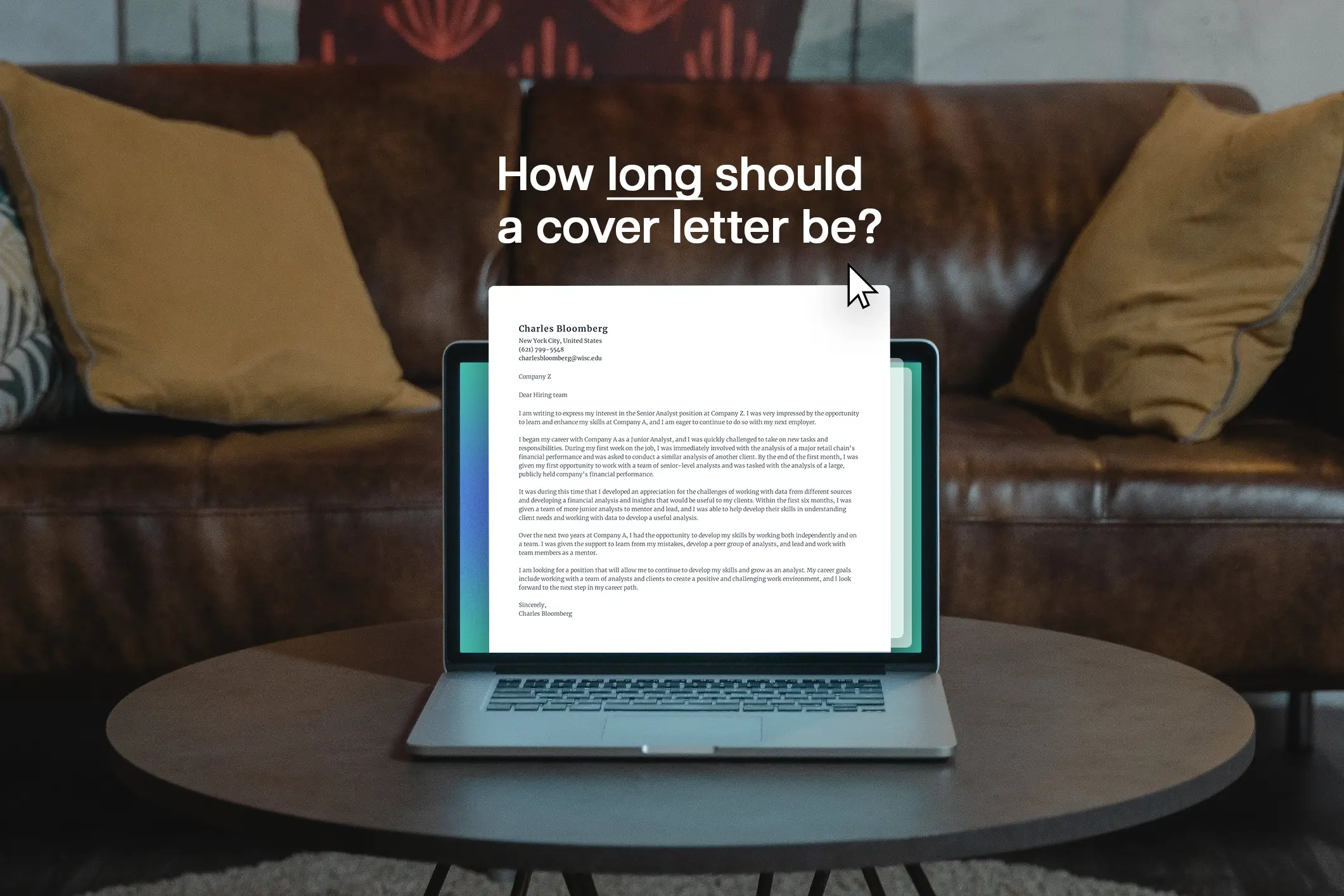Thirty-six percent of hiring managers spend less than 30 seconds reading a cover letter. It’s a strong indicator that they’re not interested in long cover letters that don't quickly communicate the value you can bring to a role.
But what do hiring managers have to say about this, and what can you do to optimize your cover letter? We’ll answer these questions, examine the key elements every cover letter should include, and take a look at tips to keep your cover letter short and sweet. Let’s get to it.
Do Hiring Managers Prefer Long or Short Cover Letters?
Seventy percent of surveyed recruiters prefer a shorter cover letter. The ideal cover letter length should be between half a page and one page, which equates to 250–400 words spread over three to five paragraphs. That means your cover letter needs to be concise.
The goal of a cover letter is to provide more information on how your professional qualifications and experience make you a good fit for a specific role—so focus on emphasizing your value.
Dr. Kyle Elliott, Founder and Tech Career Coach at Kyle Elliott Consulting advises the following practices when approaching a cover letter:
“Your cover letter doesn't need to summarize your resume, which is a common mistake many job seekers make. Rather, use it as an opportunity to highlight what sets you apart from the hundreds, or thousands, of people applying for the same role as you. Additionally, spend a sentence or two communicating what drew you to this specific company. Finally, include a clear call to action inviting the interviewer to meet with you to further discuss your candidacy.”
While it’s important to be mindful of length, that shouldn’t be your only focus. Use as many words as you need to communicate your value, without being wordy, repetitive, and going off course.
Key Characteristics of a One-Page Cover Letter
Even though many recruiters skim cover letters, they’re still essential. As much as 65% of recruiters report that cover letters influence their decision on who to interview or hire. Plus, 81% said they value customized cover letters over generic ones.
Your cover letter is your chance to set yourself apart, says Dr. Kylie Elliott:
“While not all recruiters and hiring managers read cover letters, those who do choose to read them aren't looking for a mere summary of your resume. Instead, they want to learn more about you and what sets you apart from the other people who applied for the open position.”
Here are some key features to prioritize to make sure you deliver a well-crafted cover letter.
First, as mentioned, your cover letter should be roughly half a page to a full page long and total 250–400 words. It should be divided into 3–5 paragraphs for easy scanning, and each paragraph should have a clear focus (we dive into the specifics of what to cover in each paragraph, below).
You should also pay attention to your cover letter formatting. Messy formatting comes across as unprofessional and can hurt your application, say surveyed recruiters and hiring managers. Plus, formatting is key to making it through applicant tracking systems (ATS).
- Font: Choose standard fonts such as Calibri and Georgia that are easy to read and scan, with a font size between 10 and 12.
- Spacing and alignment: Your cover letter should have enough white space. It should also be aligned to the left with a standard 1-inch margin. This makes for a clean and uncluttered look.
- Format: For easy identification and assessment, name your document properly and send it in PDF format. Pay attention to any recruitment criteria on how to name and format your cover letter.
Cover Letter Outline and Word Count
No matter the length of your cover letter, there are certain elements it absolutely must include.
We’ll take a look at each, and give our advice on optimizing each section—so you’re delivering maximum value while keeping your cover letter at the correct length.
Header
This is the first part of your cover letter and contains your contact details: such as your full name, email address, phone number, and link to a professional profile. It may also include the receiver’s details like the recruiter’s professional title, company name, and address.
This should be approximately 20 words.
Greeting
This is where you address the recruiter or hiring manager. If you don’t know their name, your greeting can reference their role, i.e. “Dear hiring manager.” Preferably, address them by their full name as this shows you’ve taken the time to do your research.
Opening statement
This is where you introduce yourself and briefly outline why you’re the best fit for the role. You can also place a core achievement here to capture the recruiter or hiring manager’s attention.
This section should be roughly 50 to 70 words. Focus on information that’s specifically relevant to the role and will make your application stand out.
Body
This is the crux of the cover letter where you sell yourself by stating relevant experience, skills, and qualifications that make you the best fit for the role. The body of the cover letter is usually two to three paragraphs.
In the first paragraph, include information on achievements from past roles and outline how you can replicate these results for this new company.
In the second paragraph, include some of your key skills and match these against those outlined in the job description. Note how you applied them in past endeavors.
The third paragraph should contain information on your professional qualifications, courses taken, and more.
The cover letter body should be about 150–200 words to keep within our guidelines for cover letter length.
Closing paragraph
The closing paragraph is where you’ll tie up everything written so far. You should thank the recruiter for their time and include a call to action (CTA), like: “I look forward to hearing from you and am available to discuss my skillset at your earliest convenience.” This should be about 50 words.
Complimentary close
The complimentary close includes a formal closing statement, such as “Warm regards,” “Sincerely,” or “Best.”
How to Keep Your Cover Letter the Correct Length
Here are some cover letter tips to help you make a great impression and boost your chances of getting interviewed.
Tip 1: Break it into sections
An ideal cover letter contains an opening statement, a body, and a closing paragraph.
The first section should contain information about you and your professional background. The next section should focus on your skills, relevant experiences, and how you intend to use them in this new role. The last section contains your closing statement and CTA.
By breaking your cover letter into logically arranged sections that have set parameters, you’ll avoid repeating information.
Tip 2: Follow professional formatting
The formatting of your cover letter also determines its length. First, embrace whitespace. Single or 1.5 spacing is ideal.
You should pick an easy-to-read and legible font, like Arial or Georgia, with a font size between 10 and 12. It’s also best to outline your skills in an essay format, where you outline their relevance, rather than bullet points that rehash your resume.
Using a cover letter template—like those offered by Rezi—will ensure you get these formatting essentials right every time.
Tip 3: Highlight only relevant skills and experiences
This is the meat of the cover letter that most hiring managers look out for. So, while it may be tempting to list all your skills and work achievements, focus on relevant information that directly relates to the job you’re applying for.
Try the STAR method, which stands for situation, task, action, and result. This helps you state how you applied your skills in a situation when carrying out certain tasks, which in turn leads to the desired result. This will demonstrate the link between your skills and experiences and highlight how you’ll add value to the team.
Tip 4: Remove fluff
Cut any unnecessary words that don’t add further meaning to what you’re saying. Removing fluff makes your cover letter more concise and easy to read.
Tip 5: Proofread and edit
Before you press send, ensure you edit your cover letter or ask someone to do this for you. This helps you identify and correct any grammatical errors, improve the flow of your sentences, and remove redundancies.
Tip 6: Check the employer’s requirements
Finally, check the job ad for information on how long the cover letter should be, as some recruiters specify the number of words they’re looking for. Ignoring that instruction will reflect badly on your application.
In situations where no word count is specified, stay within 250–400 words.
Example of a One-Page Cover Letter That’ll Impress Managers

Here’s why you should adopt this cover letter template for your next job application:
- It’s concise and straight to the point.
- It communicates the applicant’s capabilities and core information and removes unnecessary details.
- It follows the correct format, with enough white space and a font style and size that’s appropriate for an ATS.
- It’s easily scannable with short paragraphs and core details presented first.
Start Creating an Impressive Cover Letter with Rezi
A great cover letter considers both word count and the relevance of information. Don’t focus solely on how long the letter is, as this may force you to eliminate core details that make you stand out.
The best way to approach writing your cover is by listing all the relevant information that showcases you as a great fit for a job, and then using a template to help you narrow your points down to the essentials.
With the Rezi cover letter generator, you have myriad short cover letter samples to choose from—making your job application process that much easier.
They are optimally formatted and can be tailored to the role and organization with just a few clicks. And you can tailor your application further by using our resume builder, and boost your chances of getting that dream job.
Sign up to create your short cover letter.
FAQs
1. Is a 500-word cover letter too long?
A 500-word cover letter may be too long if it includes unnecessary information that doesn’t highlight your value. However, this length is fine if it’s filled with core details that show the recruiter why you’re the best fit for the role.
Generally, though, the rule of thumb is to write between half a page to one page, or around 250–400 words.
2. Is it OK if my cover letter is two pages?
No matter how senior you are or how much work experience you have, a two-page cover letter is overboard. Most recruiters use cover letters as a supporting document when assessing your application, so they most likely won’t have the time and energy to read a two-page cover letter.
Tech career coach Dr. Kyle Elliott has this to say:
“While a two-page cover letter may be needed in certain situations, such as when applying for an academic role or addressing specific questions requested by the prospective employer, a single-page cover letter will suffice in most cases.”
Also, the aim of your cover letter is not to rehash what’s already been stated in your resume but to emphasize key achievements that’ll make you stand out. You can do that in half a page to a full page.



